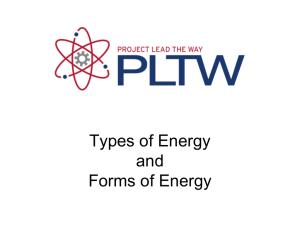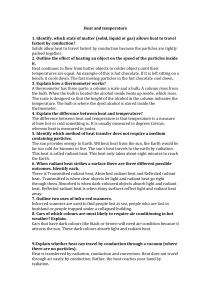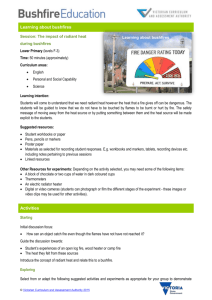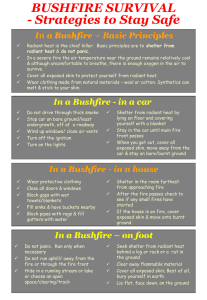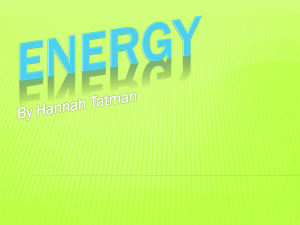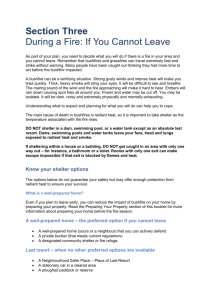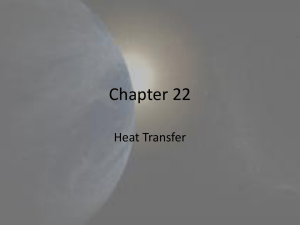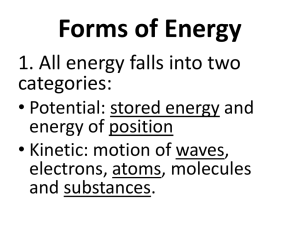Heat transfer.
advertisement
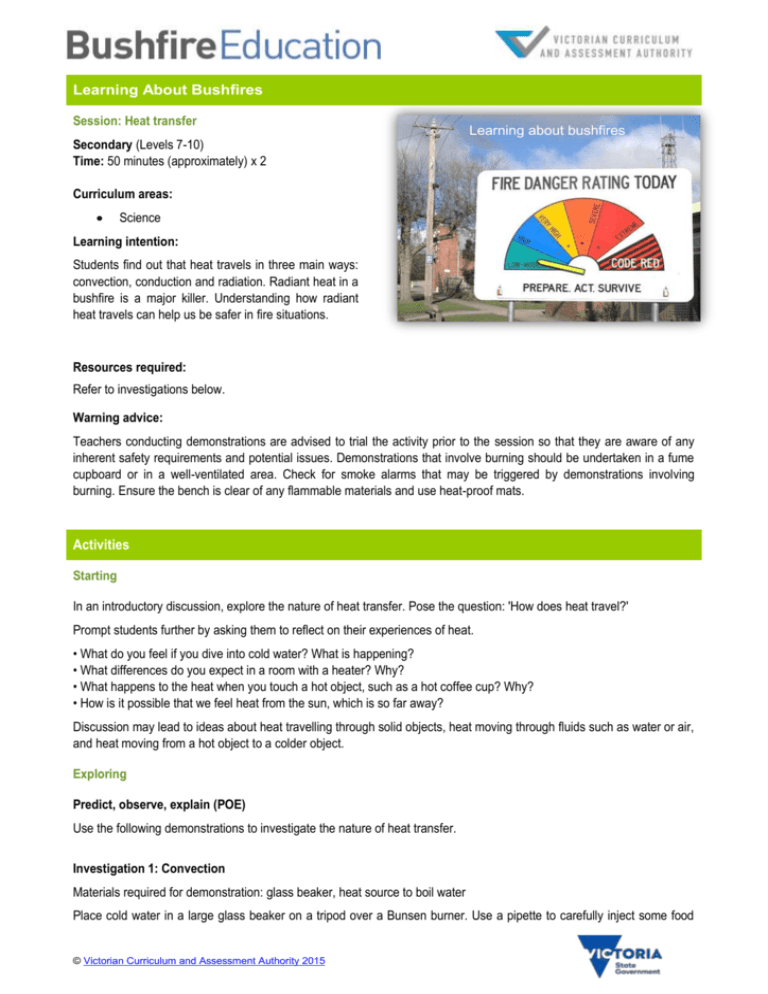
Learning About Bushfires Session: Heat transfer Secondary (Levels 7-10) Time: 50 minutes (approximately) x 2 Learning about bushfires Curriculum areas: Science Learning intention: Students find out that heat travels in three main ways: convection, conduction and radiation. Radiant heat in a bushfire is a major killer. Understanding how radiant heat travels can help us be safer in fire situations. Resources required: Refer to investigations below. Warning advice: Teachers conducting demonstrations are advised to trial the activity prior to the session so that they are aware of any inherent safety requirements and potential issues. Demonstrations that involve burning should be undertaken in a fume cupboard or in a well-ventilated area. Check for smoke alarms that may be triggered by demonstrations involving burning. Ensure the bench is clear of any flammable materials and use heat-proof mats. Activities Starting In an introductory discussion, explore the nature of heat transfer. Pose the question: 'How does heat travel?' Prompt students further by asking them to reflect on their experiences of heat. • What do you feel if you dive into cold water? What is happening? • What differences do you expect in a room with a heater? Why? • What happens to the heat when you touch a hot object, such as a hot coffee cup? Why? • How is it possible that we feel heat from the sun, which is so far away? Discussion may lead to ideas about heat travelling through solid objects, heat moving through fluids such as water or air, and heat moving from a hot object to a colder object. Exploring Predict, observe, explain (POE) Use the following demonstrations to investigate the nature of heat transfer. Investigation 1: Convection Materials required for demonstration: glass beaker, heat source to boil water Place cold water in a large glass beaker on a tripod over a Bunsen burner. Use a pipette to carefully inject some food © Victorian Curriculum and Assessment Authority 2015 dye at the bottom of the beaker, along one side. Gently heat that side of the beaker with the Bunsen burner. Have the students describe what happens: a plume of dye will rise and eventually move across the top of the water and down the cool side. Explain that the dye movement demonstrates a convection cell. Further movements of warm and cool water as highlighted by the dye shows a convection currents. This demonstration illustrates the transference of heat in a liquid through convection. The same process occurs for the transfer of heat in air and gases. Have students draw a diagram to show this, using arrows to show convection currents at work in convection heating system in a house. Investigation 2: Conduction Materials required for demonstration: glass beaker, 2 metal spoons, 2 squares of chocolate, heat source to boil water. Optional activity: steel rod, retort stand, 4-5 small birthday candles, heat source. Take two metal spoons. Place one metal spoon in the boiling water. After a minute take out the spoon and place it beside the other spoon. Place a square of chocolate in each. Observe that the chocolate melts on the spoon that was dipped in boiling water. Ask students to infer what is happening and explain why. They should be able to explain that the heat is transferred from the boiling water to the spoon and from the spoon to the chocolate. The metal spoon has increased heat energy. Describe this transfer of heat energy as conduction, where two objects of a different temperature come into contact with each other and energy transfer takes place. Optional: Set up a long steel rod in a retort stand with birthday candles set into place at regular intervals. Place one end of the rod close to or in contact with the heat source. Have students predict what will happen. Use this demonstration to apply their understanding of conduction. Advice: Teachers conducting demonstrations are advised to discuss safety requirements with students before conducting these experiments and demonstrations. Investigation 3: Radiation Materials required for demonstration: an electric bar radiator (or heat lamp or, if available, an infrared lamp), a thermometer with tip blackened. Teacher note: The end of the thermometer is blackened to increase the radiant heat absorbed by the thermometer. This is an attempt to measure radiant heat rather than heat from convection. Using an electric bar radiator, heat lamp or infrared lamp, establish that radiant heat decreases with distance from the heat source. Ensure that safety precautions are followed. Blacken the bottom end of a thermometer with black felt-tip marker. Measure the temperature at regular intervals (e.g. 25 cm) from the heat source. From their observations of the data, particularly if displayed as a line graph, students should be able to see a relationship between the distance from the radiant heat source and the drop in temperature. Describe this transfer of heat energy as radiation. Introduce the term 'radiant heat' to describe the heat energy that travels in straight lines. Radiant heat is a form of light energy (electromagnetic radiation). After the three demonstrations above, ask students to predict which of these three types of heat transfer - convection, conduction or radiation - could potentially be a killer in a bushfire. Ask students to provide their reasoning. Investigation 4: The transfer of radiant heat Materials required for demonstration: an electric bar radiator or heat lamp, a thermometer with tip blackened, a pane of glass, a timber board, thick fabric, aluminium foil, a ruler. Set up a sheet of glass 30 cm from the heat source. Identify the temperature immediately in front of the glass pane. Ask students to predict the temperature immediately behind the glass. Measure the temperature and have students explain their observations. © VCAA 2015 Page 2 Pose the question: 'Does radiant heat pass through all materials?' Continue as a demonstration or have students investigate using a heat lamp. Replace the glass pane with a timber board. Use the POE strategy to investigate the effect of changing the type of material. Students should make the connection between the significantly lower temperature immediately behind the timber board and its property of blocking radiant heat. Investigate other materials such as thick fabric, a sheet of metal and a sheet of aluminium foil. Record results in a table and have students working in pairs to explain their observations. Make a list of claims students make about radiant heat. Some examples may include: Claim: The further away from the heat source, the less radiant heat. Evidence: The further the distance from the radiator, the lower the temperature. Claim: Solid materials such as walls and buildings block radiant heat. Evidence: When these materials were placed in front of the radiator, the temperature immediately behind these materials was much lower. Claim: Radiant heat can pass through the windows of a house. Evidence: They are made from glass and the temperature measured immediately behind the glass pane was about the same as in front of the glass. Claim: Shutters on the outside or thick curtains on the inside of a window can block radiant heat. Evidence: When materials such as metal, wood and thick fabric were placed in front of the radiator, the temperature immediately behind the materials was much lower. Bringing it together Return to a general discussion by posing the following questions. Based on your knowledge of heat transfer, what are some of the implications for staying safe in fire situations? What changes would you make to your house to reduce the effects of radiant heat? What actions would you take if a bushfire was close to your house? Ensure students understand the key safety message regarding radiant heat and bushfires. Radiant heat travels in straight lines. The further away from the heat source the less radiant heat. Certain solid materials block radiant heat. Radiant heat can pass through glass. Excessive radiant heat can cause tissue damage and death. Extending Not applicable to this session. © VCAA 2015 Page 3
